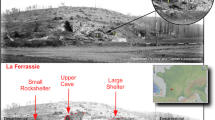Abstract
Karst landscapes develop in soluble rocks, such as carbonates and evaporates, but also in various types of rocks that develop pseudokarst features. The main aim of this work is to introduce a new karst map of Georgia (scale: 1:1,500,000) presenting karst and pseudokarst features, which occupy about 17.9% (12,454 km2) of the entire territory of the country and include over 1500 known caves. We distinguish two types of karst features—karst (developed in carbonate rocks) and pseudokarst, and also five subtypes, mainly based on their lithology. About 10.2% (7120 km2) of the country is occupied by karst (carbonate rocks), and about 7.7% (5334 km2) of the country is occupied by pseudokarst features. This karst map of Georgia will provide important assistance to local and foreign researchers interested in studying Georgian karst features.



Similar content being viewed by others
References
Asanidze L, Chikhradze N, Lezhava Z, Tsikarishvili K, Polk JS, Lominadze G, Bolashvili N (2017a) Complex speleogenetic processes and mineral deposition in the Caucasus region of Georgia. J Environ Biol 38:1107–1113
Asanidze L, Lezhava Z, Tsikarishvili K, Chikhradze N, Polk JS (2017b) Karst morphological processes and evolution of the limestone massif of Georgia from depositional, sedimentary, and structural investigations in Muradi cave. In: Proceedings of 17th international congress of speleology. Sydney, Australia, pp 241–247
Asanidze L, Avkopashvili G, Tsikarishvili K, Lezhava Z, Chikhradze N, Avkopashvili M, Samkharadze Z, Chartolani G (2017c) Geoecological monitoring of Karst Water in Georgia, Caucasus (case study of Racha limestone Massif). Open J Geol 7:822–829
Asanidze L, Chikhradze N, Lezhava Z, Tsikarishvili K, Polk JS, Chartolani G (2017d) Sedimentological study of caves in the Zemo Imereti Plateau, Georgia, Caucasus region. Open J Geol 7:465–477
Asanidze L, Lezhava Z, Chikhradze N (2017e) Speleological Investigation of the Largest Limestone Massif in Georgia (Caucasus). Open J Geol 7:1530–1537
Asanidze L, Lezhava Z, Chikhradze N, Gaprindashvili G, Avkopashvili G (2018) Mapping of potential show caves in the Racha Limestone Massif (Country of Georgia). In: Proceedings of the 15th multidisciplinary conference on sinkholes and the engineering and environmental impacts of Karst and the 3rd Appalachian Karst symposium. Shepherdstown, West Virginia, US, pp 97-103
Bar-oz G, Belfer-Cohen A, Meshveliani T, Djakeli N, Bar-Yosef O (2008) Taphonomy and zooarchaeology of the upper palaeolithic cave of Dzudzuana, Republic of Georgia. Int J Osteoarchaeol 18:131–151
Chirakadze G (1972) Climatic parameters of the natural moisture content of Transcaucasia. In: Papers of Transcaucasus scientific researches of the Institute of Hydrometeorology, issue 50 (56), Gidrometeoizdat (In Russian)
Demidov P (2017) The deepest cave in the world. UIS Bull 59–2:49–51
Ford DC, Williams PW (2007) Karst geomorphology and hydrology. Wiley, Hoboken, p 576. https://doi.org/10.1002/9781118684986
Gamkrelidze P (1964) Tectonics. In the book: Geology of the USSR, vol X. The Georgian SSR “Nedra” (In Russian)
Gudjabidze G (2003) Geological map of Georgia, scale: 1:500,000, Georgian. State Department of Geology and National Oil Company “Saqnavtobi”, Tbilisi
Gudjabidze G, Kandelaki D, Geguchadze Sh, Jighauri D, Torozov R, Pruidze M, Adamia Sh, Javakhishvili Sh, Tsagareli A, Buleishvili D, Edilashvili V (1977) Geological maps of Georgia, scale: 1:200,000. Ministry of Geology, Tbilisi
Gunn J (2004) Encyclopedia of caves and karst science. Taylor and Francis Group, New York
Kipiani S (1974) Karst of Georgia (attempt of geomorphological characterization) V-I. Publishing House Metsniereba, Tbilisi (In Georgian)
Klimchouk AB (2012) Krubera (Voronja) Cave. Encyclopedia of caves. Ukrainian Institute of Speleology and Karstology, Simferopol, pp 443–450
Kordzakhia M (1961) Climate of Georgia. Tbilisi (In Russian)
Lezava Z, Bolashvili N, Tsikarishvili K, Asanidze L, Chikhradze N (2015) Hydrological and Hydrogeological Characteristics of the Platform Karst (Zemo Imereti Plateau, Georgia). Sinkholes and the Engineering and Environmental Impacts of Karst. In: Proceedings of the 14th multidisciplinary conference, Rochester, Minnesota, US, pp 93–100
Lezhava Z (2015) The Karst of Zemo Imereti Plateau and its surrounding areas. Publishing House Universali, Tbilisi (In Georgian)
Maruashvili L (1973) Fundamentals of speleology. Publishing House Universali, Tbilisi (In Georgian)
Palmer AN (2007) Cave geology. Cave Books, Dayton
Pulina M (1971) Observations on the chemical denudation of some karst areas of Europe and Asia. Studia geomorphologica Carpatho-Balcanica, vol 5. Krakow, Poland
Sendra A, Reboleira SP (2012) The world’s deepest subterranean community—Krubera-Voronja Cave (Western Caucasus). Int J Speleol 41(2):221–230
Stokes T, Griffits P, Ramseay C (2010) Karst geomorphology, hydrology, and management. Compend For Hydrol Geomorphol B C Land Manag Handb 11:373–400
Szukalski BW (2002) Introduction to cave and karst GIS. J Cave Karst Stud (Special Issue) 64(1):3
Tatashidze Z, Tsikarishvili K, Jishkariani J, Jamrishvili Geladze G (2009) Tskaltubo Cave System. Petiti Publishing House, Tbilisi (In Georgian)
Tintilozov ZK (1961) Rare stalactite shapes and concretions in the karstic caves of western Georgia. In: Proceedings of the Vakhushti Bagrationi Institute of Geography, Georgia Academy of Sciences. Tbilisi, pp 23–25 (In Georgian)
Tintilozov ZK (1976) Karst Caves of Georgia (morphological analysis). Tbilisi, 275 (In Russian)
Tsikarishvili K, Barjadze S, Kvavadze E, Bolashvili N, Djanashvili R, Martkopishvili I (2010) Speleology of Georgia: aspects of its current situation and perspectives. Cave Karst Sci 37(3):73–78
Vladimirov LA, Shakarishvili DI, Gabrichidze TI (1974) Water balance of Georgia. Tbilisi: Metsniereba
Waele JD, Plan L, Audra P (2009) Recent developments in surface and subsurface karst geomorphology: an introduction. Geomorphology 106(2009):1–8
White W, Culver D, Herman J, Kane T, Mylroie J (1995) Karstlands. Am Sci 83:450–459
Funding
Funding was provided by TSU Vakhushti Bagrationi Institute of Geography and the grant of the International Education Center of Georgia (MES 91701063435).
Author information
Authors and Affiliations
Corresponding author
Additional information
Publisher's Note
Springer Nature remains neutral with regard to jurisdictional claims in published maps and institutional affiliations.
Rights and permissions
About this article
Cite this article
Asanidze, L., Lezhava, Z., Tsikarishvili, K. et al. Karst map of Georgia (Caucasus region) scale: 1:1,500,000. Carbonates Evaporites 34, 1205–1212 (2019). https://doi.org/10.1007/s13146-019-00525-z
Accepted:
Published:
Issue Date:
DOI: https://doi.org/10.1007/s13146-019-00525-z




